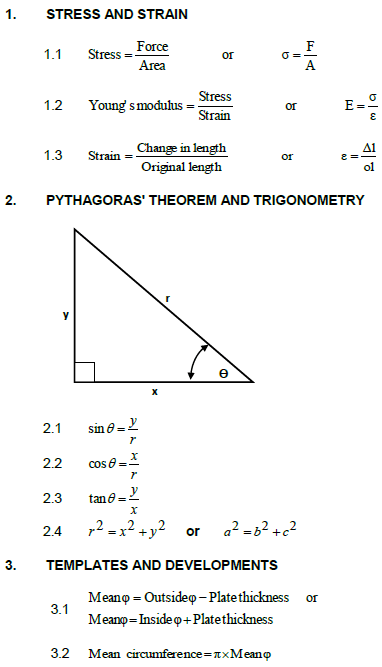Mechanical Technology: Welding and Metalwork Questions - Grade 12 September 2021 Preparatory Exams
Share via Whatsapp Join our WhatsApp Group Join our Telegram GroupINSTRUCTIONS AND INFORMATION
- Write your NAME and SURNAME on the ANSWER BOOK.
- Read ALL the questions carefully.
- Answer ALL the questions.
- Number the answers correctly according to the numbering system used in this question paper.
- Start EACH question on a NEW page.
- Show ALL calculations and units. Round off final answers to TWO decimal places.
- Candidates may use non-programmable scientific calculators and drawing instruments.
- The value of gravitational force should be taken as 10 m.s-2.
- All dimensions are in millimetres, unless stated otherwise in the question.
- A formula sheet is attached to the question paper.
- Write neatly and legibly.
- Use the criteria below to assist you in managing your time.
QUESTION | CONTENT | MARKS | TIME IN MINUTES |
GENERIC | |||
1 | Multiple-choice questions | 6 | 6 |
2 | Safety | 10 | 10 |
3 | Materials | 14 | 14 |
SPECIFIC | |||
4 | Multiple choice questions | 14 | 10 |
5 | Terminology (Templates – rolling and bending) | 23 | 20 |
6 | Tools and Equipment | 18 | 20 |
7 | Forces | 45 | 30 |
8 | Joining methods (Inspection of welds) | 23 | 20 |
9 | Joining methods (Stresses and distortion) | 18 | 20 |
10 | Maintenance | 8 | 10 |
11 | Terminology (Specific) | 21 | 20 |
TOTAL: | 200 | 180 | |
QUESTIONS
QUESTION 1: MULTIPLE-CHOICE QUESTIONS (GENERIC) (COMPULSORY)
Various options are provided as possible answers to the following questions. Choose the correct answer and write only the letter (A–D) next to the question numbers (1.1–1.6) in the ANSWER BOOK, for example 1.7 A.
1.1 Which ONE of the following safety procedures is applicable to the maintenance/operation of a hydraulic press?
- Do not apply a wrench to revolving work.
- Guards could be removed when pressing soft material.
- Pressure gauges must be tested regularly and adjusted or replaced if any malfunctioning occurs.
- Use the machine table as an anvil. (1)
1.2 What is the best way of dealing with a hazard to ensure others are not put at risk?
- Remove it immediately
- Leave it for the supervisor to sort out
- Not placing a barrier tape around it
- Display a notice or warning sign (1)
1.3 Which of the following is a safety precaution related to a workbench?
- The tool rest must not be more than 3 mm from the grinding wheel.
- Make sure the chuck is correctly tightened.
- Stand on the side when switching on the machine.
- Keep rolling stock or items away from the bench end. (1)
1.4 What is the colour of an acetylene cylinder?
- Maroon
- Grey
- Green
- Black (1)
1.5 Starting devices on machinery are normally … in colour.
- red
- green
- black
- orange (1)
1.6 ONE of the following is NOT a safety device used in conjunction with guillotines.
- Self-adjusting guard
- Current scale
- Automatic sweep-away
- Electronic presence detection sensor (1)
[6]
QUESTION 2: SAFETY (GENERIC)
2.1 State TWO safety precautions that should be observed before pressing a bearing from a shaft using a hydraulic press. (2)
2.2 Sketch and label a product layout. (2)
2.3 What is the reason for mounting a Perspex shield on a bench grinding machine? (1)
2.4 Study both pictures in FIGURE 2.4 and answer the questions that follow.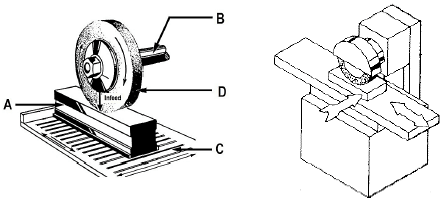
FIGURE 2.4
2.4.1 Name the machine shown in FIGURE 2.4. (1)
2.4.2 Identify the parts labelled A to D. (4)
[10]
QUESTION 3: MATERIALS (GENERIC)
3.1 Explain the term heat treatment. (2)
3.2 Tabulate the following heat PROPERTY of each. treatment processes and identify ONE PROPERTY of each.
| PROCESS | PROPERTY |
| 3.2.1 Hardening | |
| 3.2.2 Tempering | |
| 3.2.3 Annealing | |
| 3.2.4 Normalising |
(4 x 1) (4)
3.3 Describe the specific purpose for case-hardening mild steel. (2)
3.4 What effect does carbon have when hardening steel? (2)
3.5 Name TWO workshop tests which are used to make a distinction between materials. (2)
3.6 State TWO reasons for annealing as a heat-treatment process. (2)
[14]
QUESTION 4: MULTIPLE-CHOICE QUESTIONS (SPECIFIC)
Various options are provided as possible answers to the following questions. Choose the answer and write only the letter (A–D) next to the question numbers (4.1–4.14) in the ANSWER BOOK, for example 4.15 E.
4.1 Which ONE of the following statements is a basic rule for the safe handling of a press machine?
- Use a hammer to get the workpiece into position.
- The safety guard must be in place before you can start the press machine.
- Never leave the machine running if it is unattended.
- The safe working pressure must never be exceeded. (1)
4.2 Template makers have their own hand tools, such as …
- spanners.
- micrometres.
- chalk line and reel.
- sockets. (1)
4.3 What is a plate girder?
- Hollow tubing welded together.
- Combination of plates and angle iron welded together.
- Retro grids welded together.
- Combination of plates and round bars welded together. (1)
4.4 All symbols that appear above the reference line refer to welding to be done on … of the joint to which the arrow head is pointing.
- this side
- the right-side
- the left-side
- the other side (1)
4.5 Supplementary symbols indicate … information about a weld.
- additional
- calculated
- difficult
- easy (1)
4.6 The pitch is the distance from a reference point on the thread to a corresponding point on the thread ahead of it, measuring parallel as to the
… of the shaft.
- root
- crest
- axis
- screw (1)
4.7 A die is used for cutting or forming external threads on round bars and …
- square tubing.
- shafts.
- plates.
- angle iron. (1)
4.8 Arc welding is a type of welding that uses a welding supply to create an electric arc between an …
- earth terminal and electrode.
- electrode and base metal.
- electrode and electrode terminal.
- base metal and earth terminal. (1)
4.9 What is the function of spot welding?
- It is very quick and easy.
- It is safe.
- It converts AC to DC.
- The electrical resistance is very low. (1)
4.10 What is the individual members of steel frameworks such as roof trusses called that make up the structure to support the frame structure?
- Columns
- Struts and ties
- Rafters
- Purlins (1)
4.11 A UDL is a load that is spread over a certain distance. Give the meaning of UDL.
- Uniformly decreased load
- Uniformly deliberate load
- Uniformly disinclined load
- Uniformly distributed load (1)
4.12 Which of the following steps should be followed during oxy-acetylene welding?
- Correct flame for the work at hand.
- Correct angle of the blow torch and rod.
- The rate of progress along the joint.
- All of the above. (1)
4.13 What is the most common cause of heat-affected zone (HAZ) cracks in a weld?
- Excessive oxygen
- Excess hydrogen
- Excess carbon.
- Excess nitrogen. (1)
4.14 How can friction be reduced when drilling holes?
- Reduce feed speed.
- Reduce drill speed.
- Apply lubrication.
- All of the above. (1)
[14]
QUESTION 5: TERMINOLOGY (TEMPLATES – ROLLING AND BENDING)
5.1 What is the purpose of purlins in roof trusses? (2)
5.2 Give ONE reason why stiffeners are used in beams. (1)
5.3 What is the use of strip templates? (1)
5.4 What does templates indicate? (2)
5.5 FIGURE 5.5 below shows the shoe of a steel roof truss. Label the components (A–E), as indicated on the drawing. (5)
FIGURE 5.5
5.6 Sketch the welding joints that the following weld symbols represent.
5.6.1 ![]() (3)
(3)
5.6.2  (3)
(3)
5.7 FIGURE 5.7 shows a pipe clamp. The flat bar of 75 mm wide and 12 mm thick is used to form 40 clamps. Calculate the length of material required to manufacture 20 clamps.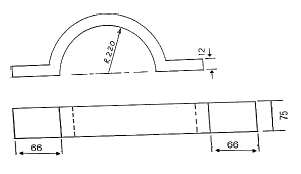 (6)
(6)
[23]
QUESTION 6: TOOLS AND EQUIPMENT
6.1 Name TWO different types of tap wrenches used in the welding workshop. (2)
6.2 What is the main uses of bench grinders in a workshop? (2)
6.3 State the purpose of a powersaw. (1)
6.4 How would you determine the drilling speed of a pedestal drilling machine? (2)
6.5 Give TWO reasons why guillotines have material thickness cutting limits. (2)
6.6 With the aid of a line diagram, SKETCH the basic operational principles of a AC arc welding machine, indicating the welding circuit. (7)
6.7 Why is shielding gas used in MIG welding? (2)
[18]
QUESTION 7: FORCES
7.1 Define the following terms:
7.1.1 Stress (2)
7.1.2 Strain (2)
7.1.3 Safety factor (2)
7.2 A tensile force of 50 kN is exerted onto a round bar with a diameter of 50 mm and an original length of 3 m. Determine by means of calculations:
7.2.1 The stress in the material (4)
7.2.2 The strain if the final length of the bar is 3,005 (3)
7.3 Make a neat, labelled sketch to show the stress strain graph. (7)
7.4 The FIGURE 7.4 below shows a uniform beam that is been supported by two vertical supports LR and RR.
Two vertical point loads are exerted onto the beam, as well as a uniformly distributed load of 50 N/m, over the total left half of the beam.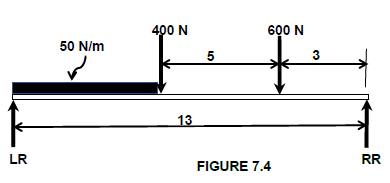
FIGURE 7.4
7.4.1 Calculate the reactions at the supports LR and RR. (6)
7.4.2 Calculate the BM at each point of the beam A, B, C and D. (4)
7.4.3 Calculate the shear force at A, B, C and D. (4)
7.5 FIGURE 7.5 below, show a framework with two vertical loads of 10 Kn each.
HINT: Copy and draw the space diagram as shown.
Determine GRAPHICALLY the nature of the forces by means of completing the force diagram.
Scale: 10 mm = 1 kN
2 m = 20 mm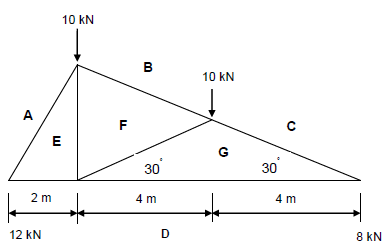 (11)
(11)
[45]
QUESTION 8: JOINING METHODS (INSPECTION OF WELDS)
8.1 Name THREE internal defects that may be detected when conducting a nickbreak test on a welded joint. (3)
8.2 State THREE visual requirements for an acceptable weld. (3)
8.3 Name THREE elements that should be inspected during the visual inspection of an arc welded joint. (3)
8.4 Describe the steps to be followed when performing an X-ray test on a welded joint. (5)
8.5 Name the factors that determine the current setting in arc welding. (3)
8.6 State THREE factors that should be considered during oxy-acetylene welding to ensure quality welding. (3)
8.7 State THREE preventative measures for porosity during MIG welding. (3)
[23]
QUESTION 9: JOINING METHODS (STRESSES AND DISTORTION)
9.1 State FIVE methods used to reduce distortion. (5)
9.2 What is distortion on a welded joint? (2)
9.3 Describe the meaning of shrinkage in a welded joint. (2)
9.4 The figure below shows the iron-carbon equilibrium diagram. Label the structures according to the letters (A–E).(5)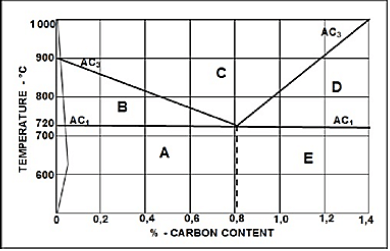
9.5 Name the factors that affect the grain size of steel when it is being cold worked. (4)
[18]
QUESTION 10: MAINTENANCE
10.1 Why do tagging plates have multiple holes? (2)
10.2 State TWO general maintenance guidelines for a pedestal drilling machine. (2)
10.3 Give TWO reasons for the maintenance of machines in the welding workshop. (2)
10.4 Name TWO methods to reduce friction when drilling holes. (2)
[8]
QUESTION 11: TERMINOLOGY (SPECIFIC)
Calculate the following true lengths on the hopper shown below:
11.1 Calculate the true length of 1 – 2, 2 – 3, 3 – 4. (4)
11.2 Calculate the true length of 1 – x. (4)
11.3 Calculate the true length of 1 – a. (5)
11.4 Calculate the true length of 2 – a. (6)
11.5 Calculate the length of a – x.
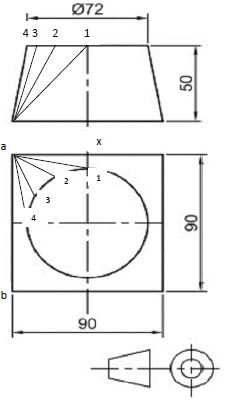 (2)
(2)
[21]
TOTAL: 200
FORMULA SHEET FOR MECHANICAL TECHNOLOGY (WELDING AND METALWORK)
